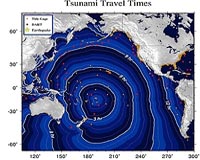| . |  |
. |
Jakarta (AFP) Oct 1, 2009 Scientists have warned for years that the Indonesian city of Padang is a disaster waiting to happen because of strain on a nearby fault-line. After this week's quake they say worse is still to come. The city on Sumatra island is located between two lines of high seismic activity -- the Great Sumatran fault on the mainland to the east, and the Sumatra trench, also called the Sunda trench, under the ocean to the west. Scientists have long anticipated a major quake there, as parts of the Indo-Australian plate and the Eurasian tectonic plates bump and ride over each other as part of the jostling mosaic of the Earth's crust. Predictions have been issued "since early 2004, before the great 2004 tsunami and earthquake," California Institute of Technology (Caltech) geologist Kerry Sieh told AFP, referring to the Indian Ocean disaster that killed more than 220,000. The 7.6-magnitude quake that struck the West Sumatra capital on Wednesday killed more than 700 people and left thousands buried under rubble in the city of nearly a million people. But pressure in the area caused by the meeting of the two plates means a vastly larger 8.8-magnitude quake, coupled with an ensuing five-metre-high wall of water, is a virtual certainty in the coming decades, Sieh said. "This earthquake today is a flea compared to this tiger of a quake that is coming," he said. "It's 100 percent likely. The question is when is the date. The strain has been building off Padang for this 8.8 for 175 years." The fears for Padang have been generated by a domino-like series of events on the Sunda trench since 2004. When one section ruptures, intense stress applies to the next part of the fault, making it more vulnerable to a bust. A series of big shakes -- including a magnitude 8.2 that struck Bengkulu province in September 2007, and one off Aceh that triggered the 2004 tsunami -- showed that all the segments had released their energy, except that of Padang. A pair of European seismologists confirmed on Thursday that the quake was not the big release of strain on the fault-line that had been predicted. Wednesday's quake, they said, came from a unexpected site. It was pinpointed some 80 kilometres (50 miles) below the seabed, apparently where the Australian plate is "subducted" -- forced into a tortuous slide beneath the Sunda plate. "The event yesterday was kind of strange, it wasn't what we would have expected," said Sandy Steacy, a professor at the Environmental Sciences Research Institute at the University of Ulster in Northern Ireland. "I suspect that structure, nobody even knew it was there. We don't have any way of mapping the faults in the subducting slab because it's so deep. It's only by having earthquakes on it that gives you an indication." Experts have called on the government to invest in quake-resistant buildings and widen Padang's roads -- predicting an exodus of about 500,000 people in the event of a major quake. But little has been done. Geological Disaster Mitigation and Volcanology Centre head Surono said there is a "perception that building such expensive infrastructure is not economically viable" because of the uncertainty of earthquake prediction. "West Sumatra is like a supermarket for geological disasters. There are active volcanoes, landslides, land quakes caused by faults," he told AFP. "Being close to the faults means Padang is always prone to earthquakes. Every day, there is a tectonic quake there, but they may be too small for any effect to be felt." The Indonesian Red Crescent society said the government had enough funds to make significant improvements to Padang's infrastructure, but money had been lost through corruption. "There's so much corruption in Indonesia and many corrupt government officials, those in all levels of government," Indonesian Red Crescent secretary-general Djazuli Ambari told AFP. "Money is available and it shouldn't be a problem building houses with strong foundations, but unfortunately, funds are misused," he said. The government's Disaster Management Agency, however, said that money was not the only issue. "It's difficult to build with materials strong enough to withstand quakes and not just bamboo and wood," agency spokesman Priyadi Kardono said. "We need time to do this." burs/adp/pst Share This Article With Planet Earth
Related Links Tectonic Science and News
 Asia trembles as 'Ring of Fire' sees new deadly quakes
Asia trembles as 'Ring of Fire' sees new deadly quakesHong Kong (AFP) Oct 1, 2009 Asia trembled this week as earthquakes hit in Indonesia and the South Pacific along the "Ring of Fire," a stretch of seismic fury responsible for most of the world's tremors and volcanoes. But experts said that although one earthquake can sometimes can set off another, that was not the case in this week's disasters which struck Indonesia's Sumatra and the once-idyllic Samoan islands. ... read more |
|
| The content herein, unless otherwise known to be public domain, are Copyright 1995-2009 - SpaceDaily. AFP and UPI Wire Stories are copyright Agence France-Presse and United Press International. ESA Portal Reports are copyright European Space Agency. All NASA sourced material is public domain. Additional copyrights may apply in whole or part to other bona fide parties. Advertising does not imply endorsement,agreement or approval of any opinions, statements or information provided by SpaceDaily on any Web page published or hosted by SpaceDaily. Privacy Statement |